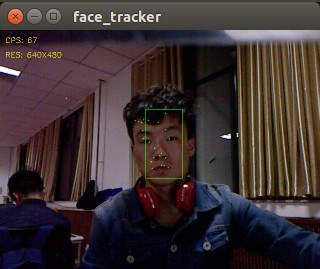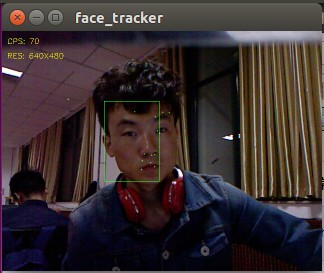原创博客:转载请标明出处:http://www.cnblogs.com/zxouxuewei/
图像流水线如下:
detect_face() → get_keypoints() → track_keypoints()
节点流水线如下:
face_detector.py() → good_features.py() → lk_tracker.py()
我们的节点face_tracker.py实现了以上过程。
首先确保你的kinect驱动或者uvc相机驱动能正常启动:(如果你使用的是kinect,请运行openni驱动)
roslaunch openni_launch openni.launch
如果你没有安装kinect深度相机驱动,请看我前面的博文。
然后运行下面的launch文件:
roslaunch rbx1_vision face_tracker.launch
在视频窗口的最前端,在键盘上输入‘c’键。清除当前的关键点,强制重新检测检测面部。
以下是我的运行结果:

移动后的追踪如下:

看看节点代码:主要是face_tracker.py节点。
#!/usr/bin/env python """ face_tracker.py - Version 1.1 2013-12-20 Combines the OpenCV Haar face detector with Good Features to Track and Lucas-Kanade optical flow tracking. Created for the Pi Robot Project: http://www.pirobot.org Copyright (c) 2012 Patrick Goebel. All rights reserved. This program is free software; you can redistribute it and/or modify it under the terms of the GNU General Public License as published by the Free Software Foundation; either version 2 of the License, or (at your option) any later version. This program is distributed in the hope that it will be useful, but WITHOUT ANY WARRANTY; without even the implied warranty of MERCHANTABILITY or FITNESS FOR A PARTICULAR PURPOSE. See the GNU General Public License for more details at: http://www.gnu.org/licenses/gpl.html """ import rospy import cv2 import cv2.cv as cv import numpy as np from rbx1_vision.face_detector import FaceDetector from rbx1_vision.lk_tracker import LKTracker class FaceTracker(FaceDetector, LKTracker): def __init__(self, node_name): super(FaceTracker, self).__init__(node_name) self.n_faces = rospy.get_param("~n_faces", 1) self.show_text = rospy.get_param("~show_text", True) self.feature_size = rospy.get_param("~feature_size", 1) self.face_tracking = True self.keypoints = list() self.detect_box = None self.track_box = None self.grey = None self.prev_grey = None def process_image(self, cv_image): try: # Create a greyscale version of the image self.grey = cv2.cvtColor(cv_image, cv2.COLOR_BGR2GRAY) # Equalize the grey histogram to minimize lighting effects self.grey = cv2.equalizeHist(self.grey) # STEP 1: Detect the face if we haven't already if self.detect_box is None: self.detect_box = self.detect_face(self.grey) else: # STEP 2: If we aren't yet tracking keypoints, get them now if self.track_box is None or not self.is_rect_nonzero(self.track_box): self.track_box = self.detect_box self.keypoints = self.get_keypoints(self.grey, self.track_box) # STEP 3: If we have keypoints, track them using optical flow if len(self.keypoints) > 0: # Store a copy of the current grey image used for LK tracking if self.prev_grey is None: self.prev_grey = self.grey self.track_box = self.track_keypoints(self.grey, self.prev_grey) else: # We have lost all keypoints so re-detect he face self.detect_box = None # Process any special keyboard commands for this module if self.keystroke != -1: try: cc = chr(self.keystroke & 255).lower() if cc == 'c': self.keypoints = list() self.track_box = None self.detect_box = None except: pass # Set store a copy of the current image used for LK tracking self.prev_grey = self.grey except AttributeError: pass return cv_image if __name__ == '__main__': try: node_name = "face_tracker" FaceTracker(node_name) rospy.spin() except KeyboardInterrupt: print "Shutting down face tracker node." cv.DestroyAllWindows()